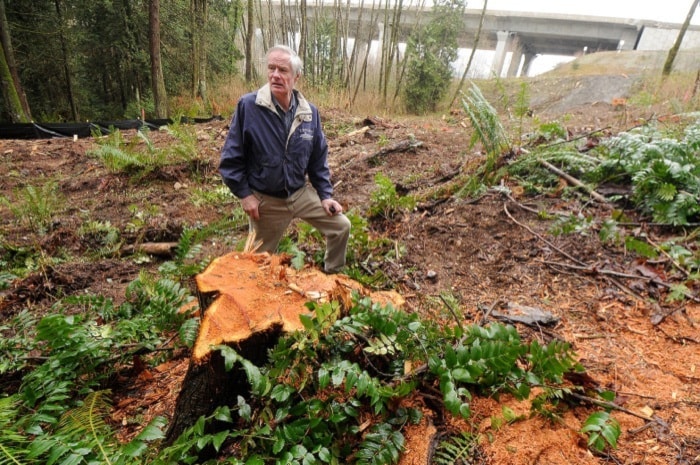Tree cutting shot up in Surrey last year as the city experienced another billion-dollar building boom in 2015.
Land cleared primarily for homes resulted in a 28-per-cent jump in the number of trees cut down.
Figures provided by the city at the request of The Leader indicate 8,560 bylaw-sized trees (30 centimetres in diameter at breast height) were cut down in 2015. It’s an increase of 1,848 large tree cuts recorded in 2014.
It also exceeds the average annual cut of bylaw-sized trees over the last 12 years, which comes in at 7,850.
Tree cutting became a contentious issue in Surrey between 2000 and 2004, when the city was issuing permits to cut down 9,100 trees per year.
Former Surrey mayor Dianne Watts, then a councillor, referred to several areas of the city as a “moonscape” because of the scope of the tree loss.
It went on to become an issue in the municipal mayoralty race in 2005, which Watts won. She then enacted the Tree Protection Bylaw in 2006, but it failed to slow the speed of cuts.
In fact, the number of trees felled annually continued at a greater rate, with 33,300 bylaw-protected trees coming down in three years (2006-2008) – or 11,100 annually (22 per cent higher than in years prior to the bylaw).
To mitigate the loss, the bylaw requires a two-to-one replacement of trees coming down, or the person cutting has to provide cash in lieu of replacement.
The city consistently falls short of the two-to-one ratio and last year, brought in $1.46 million cash in lieu for the tree fund.
That money is collected to plant trees elsewhere in the city.
The number of trees razed or damaged without permission dropped last year after a significant two-year jump in bylaw scofflaws.
Since 2009, illegal cutting has ranged between 30 and 140 per year, with 2014 being the high-water mark for infractions.
While last year wasn’t the worst year for tree cuts, some residents are still outraged by the ongoing loss of significant trees.
Raymond Griffith, 72, was upset when he saw a dozen large trees razed at the end of his street on Glen Avon Drive, near the south end of the Port Mann Bridge.
“I was quite shocked, really. It’s like somebody went in there and just desecrated the bloody place,” said Griffith, who has lived in his North Surrey home for 42 years.
“It’s a beautiful green belt and these are huge cedar trees – they’re about two-and-a-half feet across.”
City of Surrey engineering staff said the trees were removed as part of a drainage project for the East Bon Accord trunk sewer diversion. Nearby residents, staff said, were informed of the coming work.
Still, Griffith was taken aback at the size of the cut.
“Was it really necessary to remove all those big beautiful cedar trees?” Griffith said. “I have to get a permit to take a twig off my tree almost. It seems like there’s two rules.”
He argued there is ample alternative space where the city could have used that wouldn’t have disrupted trees.
A study commissioned by the city three years ago indicates Surrey will need to pay more attention to its trees if it wants to attain its goal of being a “green” city.
The 2013 report showed Surrey is losing its tree canopy (the amount of property with tree cover). A canopy of 40 per cent is considered to be one aspect of being an environmentally friendly city.
Surrey fell short of that number and continues to head in the wrong direction.
In 2001, the report showed 33 per cent of Surrey was covered by tree canopy. By 2009, that figure had dropped to 30 per cent and four years later, it had shrunk to 27.17 per cent – a decline in tree canopy of 17.66 per cent over those 13 years.
Surrey is aiming to have a 40-per-cent tree canopy by 2058, but that would require some significant changes in order to turn current trends around.
Which trees are covered by Surrey’s bylaw?
Permits aren’t required for smaller trees.
The trees the city issued permits to cut down last year were at least 30 centimetres in diameter at breast height. Or they were one of a number of protected species, such as arbutus, Garry oak, Pacific dogwood, Pacific yew, coast redwood, dawn redwood, giant redwood, maidenchair tree or monkey puzzle tree.
Trees such as cottonwood or alder are often referred to by council and staff as “scrub” trees. They either don’t have a long life cycle or don’t survive development well.
However, if they are 30 cms diameter at breast height, they require a city permit.
City-initiated cuts don’t require permits and therefore are not part of the count.
